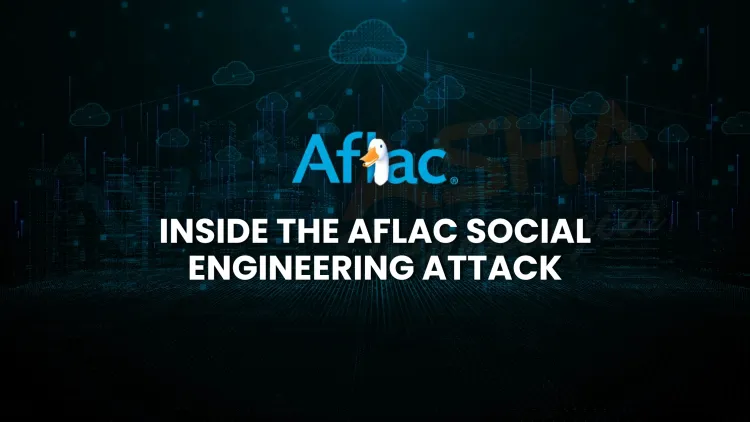What happened during the Aflac social engineering cyber attack in June 2025 and what can we learn from it?
In June 2025, U.S. insurance provider Aflac fell victim to a sophisticated social engineering attack, believed to be carried out by the Scattered Spider group. The attacker used impersonation techniques to gain unauthorized access to Aflac’s internal systems, exposing sensitive customer and employee data including Social Security numbers, health records, and insurance details. Although no ransomware was deployed, the breach had serious implications for privacy and trust. This incident underscores the urgent need for real-time threat detection, continuous monitoring, and employee training to defend against fast-moving adversaries.

Table of Contents
- What happened in the Aflac cyber attack?
- Who was behind the Aflac attack?
- Impact of the breach on Aflac and its customers
- Lessons Learned: What should companies do?
- What experts are saying
- Why social engineering is still a top threat in 2025
- Conclusion
- Frequently Asked Questions (FAQs)
What happened in the Aflac cyber attack?
In June 2025, Aflac, a major U.S. insurance company, was targeted by a social engineering cyber attack. On June 12, the company detected suspicious activity within its network. They quickly activated their incident response plan and managed to contain the attack within a few hours. However, the attacker had already exfiltrated sensitive information, including:
-
Social Security Numbers (SSNs)
-
Health-related data
-
Employee and customer policy details
The attackers did not deploy ransomware, but the data theft alone posed a major threat to customer privacy and company reputation.
Who was behind the Aflac attack?
The attack is believed to be linked to Scattered Spider, a well-known cybercriminal group that has been actively targeting industries like healthcare, aviation, and insurance.
Scattered Spider is notorious for using social engineering tactics—tricking IT support teams or employees into granting access. They often impersonate staff and bypass multi-factor authentication (MFA) protections. Once they get in, they steal sensitive data and sometimes later use ransomware.
Impact of the breach on Aflac and its customers
Although Aflac responded quickly and avoided operational disruption, the attack still had serious consequences:
| Impact Area | Details |
|---|---|
| Data Exposed | Social Security numbers, health data, policy info |
| Systems Affected | U.S. internal network |
| Attack Duration | Contained within hours |
| Method Used | Social engineering (impersonation tactics) |
| Group Suspected | Scattered Spider |
| Ransomware Used | No |
| Sector Targeted | Insurance |
| Customer Trust | Damaged due to sensitive data exposure |
Lessons Learned: What should companies do?
The Aflac incident highlights the growing speed and sophistication of attackers like Scattered Spider. Unlike traditional ransomware groups that take days to infiltrate and escalate, this group can compromise systems within hours.
Here are some key takeaways for organizations:
1. Train employees against social engineering
-
Conduct regular awareness programs.
-
Simulate phishing and impersonation attacks.
-
Teach employees to verify unusual requests, especially for access.
2. Strengthen IT helpdesk protocols
-
Enforce strict identity verification for support tickets.
-
Use adaptive authentication and zero-trust principles.
3. Implement real-time threat detection
-
Use advanced monitoring tools to catch anomalies early.
-
AI-based detection can recognize behaviors typical of insider threats or social engineering.
4. Have an incident response plan ready
-
The fast response from Aflac helped limit the damage.
-
Always test your incident response and escalation paths regularly.
What experts are saying
“If Scattered Spider is targeting your industry, get help immediately,”
— Cynthia Kaiser, Former Deputy Assistant Director, FBI Cyber Division
This quote stresses the urgency of professional cybersecurity support when dealing with high-level threat actors.
Why social engineering is still a top threat in 2025
In today’s cloud-first, remote-work environment, human error remains the weakest link. Attackers are skipping technical vulnerabilities and going straight to manipulating people. That’s why social engineering is so effective.
Social Engineering Examples:
-
Fake IT support calls
-
Phishing emails from “HR”
-
Fake MFA reset links
-
Impersonating a manager via Slack or Teams
Key Facts about Aflac Cyberattack
| Attribute | Details |
|---|---|
| Company Targeted | Aflac |
| Date of Incident | June 12, 2025 |
| Method of Attack | Social engineering (impersonation and MFA bypass) |
| Data Stolen | SSNs, health records, policy details |
| Suspected Group | Scattered Spider |
| Ransomware Involved? | No |
| Systems Affected | U.S. internal systems |
| Response Time | Breach contained within hours |
| Customer Impact | Possible identity and privacy risks |
| Key Lesson | Human-focused defense is critical |
Conclusion
The Aflac cyberattack serves as a wake-up call for the insurance sector and beyond. Even with strong infrastructure, humans are often the entry point for threat actors. Preventing future attacks depends on a combination of employee training, real-time monitoring, and strong authentication controls.
FAQs
What happened in the Aflac cyber attack in June 2025?
Aflac experienced a social engineering attack that led to unauthorized access and theft of sensitive employee and customer data.
Who was behind the Aflac social engineering attack?
The attack is believed to have been carried out by Scattered Spider, a group known for targeting critical industries with social engineering.
What type of data was stolen in the Aflac breach?
Stolen data included Social Security numbers, health information, and insurance policy details.
Was ransomware used in the Aflac cyber incident?
No, ransomware was not deployed, but the data exfiltration was significant and damaging.
When did the Aflac data breach occur?
Suspicious activity was detected on June 12, 2025.
How did the attackers gain access to Aflac systems?
They used social engineering to trick employees and bypass internal security controls.
What is social engineering in cybersecurity?
It refers to manipulating individuals into revealing confidential information or granting unauthorized access.
What is the Scattered Spider threat group?
It’s a known cybercriminal group that specializes in impersonation and bypassing MFA protections through social engineering.
What actions did Aflac take after discovering the breach?
Aflac activated its incident response plan and contained the breach within hours.
What lessons can be learned from the Aflac breach?
Organizations need fast threat detection, constant monitoring, and employee training against social engineering.
Did any customers lose money in the Aflac breach?
There is no evidence of financial loss yet, but exposed personal data poses identity theft risks.
How does social engineering bypass MFA?
Attackers often impersonate employees to trick help desk staff into resetting credentials or providing codes.
Why are insurance companies targeted by cybercriminals?
They hold valuable personal, financial, and health data which can be sold or used in fraud.
What is the FBI’s response to these attacks?
The FBI has warned organizations to seek help immediately if targeted by groups like Scattered Spider.
How fast can Scattered Spider carry out attacks?
Experts say the group can execute full-scale attacks within hours, much faster than traditional ransomware actors.
What should insurance firms do to prevent similar breaches?
Implement continuous threat monitoring, educate staff, and adopt zero-trust security principles.
Is social engineering becoming more common?
Yes, it’s one of the fastest-growing attack vectors in 2025 due to its high success rate.
What cybersecurity tools help prevent data breaches?
Tools like SIEM systems, anomaly detection, and endpoint protection can help detect and block such attacks.
Was Aflac transparent about the data breach?
Yes, Aflac disclosed the incident promptly and is working with investigators.
What industries are most at risk from social engineering?
Healthcare, insurance, finance, and aviation are high-priority targets.
How can employees protect against social engineering?
They should be trained to identify impersonation, phishing, and suspicious behavior.
What is anomaly detection in cybersecurity?
It refers to identifying unusual behavior in networks that may indicate a breach.
How do threat actors move inside a network after access?
They escalate privileges, explore systems, and exfiltrate data — sometimes deploying ransomware later.
What is zero-trust security and how does it help?
It’s a model that assumes no user or device is trusted by default, reducing the risk of internal breaches.
Did the Aflac incident involve insider threats?
While not confirmed, social engineering often leverages insider-like behavior to gain access.
How is customer trust affected by data breaches?
Trust can decline significantly, especially if health or identity information is compromised.
Can cyber insurance help in such incidents?
Yes, but proactive prevention is still critical.
What are common signs of a social engineering attack?
Urgent requests, impersonation of executives, or technical support calls asking for sensitive info.
What role does the help desk play in these attacks?
Help desks are often tricked into granting access or resetting passwords for attackers.
Is the Aflac breach still under investigation?
Yes, investigations are ongoing to determine the full extent of the breach.














![Top 10 Ethical Hackers in the World [2025]](https://www.webasha.com/blog/uploads/images/202408/image_100x75_66c2f983c207b.webp)








